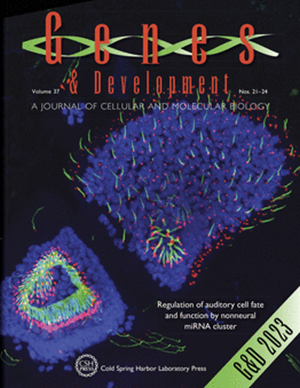Hao-Fountain syndrome protein USP7 controls neuronal differentiation via BCOR–ncPRC1.1
IF 7.7
1区 生物学
Q1 CELL BIOLOGY
引用次数: 0
Abstract
Pathogenic variants in the ubiquitin-specific protease 7 (USP7) gene cause a neurodevelopmental disorder called Hao-Fountain syndrome. However, it remains unclear which of USP7's pleiotropic functions are relevant for neurodevelopment. Here, we present a combination of quantitative proteomics, transcriptomics, and epigenomics to define the USP7 regulatory circuitry during neuronal differentiation. USP7 activity is required for the transcriptional programs that direct both the differentiation of embryonic stem cells into neural stem cells and the neuronal differentiation of SH-SY5Y neuroblastoma cells. USP7 controls the dosage of the Polycomb monubiquitylated histone H2A lysine 119 (H2AK119ub1) ubiquitin ligase complexes ncPRC1.1 and ncPRC1.6. Loss-of-function experiments revealed that BCOR–ncPRC1.1, but not ncPRC1.6, is a key effector of USP7 during neuronal differentiation. Indeed, BCOR–ncPRC1.1 mediates a major portion of USP7-dependent gene regulation during this process. Besides providing a detailed map of the USP7 regulome during neurodifferentiation, our results suggest that USP7- and ncPRC1.1-associated neurodevelopmental disorders involve dysregulation of a shared epigenetic network.浩泉综合征蛋白USP7通过BCOR-ncPRC1.1调控神经元分化
泛素特异性蛋白酶7 (USP7)基因的致病性变异导致一种称为浩泉综合征的神经发育障碍。然而,目前尚不清楚USP7的哪些多效性功能与神经发育有关。在这里,我们提出了定量蛋白质组学、转录组学和表观基因组学的结合来定义神经元分化过程中的USP7调控回路。USP7活性是指导胚胎干细胞向神经干细胞分化和SH-SY5Y神经母细胞瘤细胞神经元分化的转录程序所必需的。USP7控制Polycomb单泛素化组蛋白H2A赖氨酸119 (H2AK119ub1)泛素连接酶复合物ncPRC1.1和ncPRC1.6的剂量。功能缺失实验表明,在神经元分化过程中,bcr - ncprc1.1是USP7的关键效应因子,而ncPRC1.6则不是。事实上,BCOR-ncPRC1.1在这一过程中介导了usp7依赖性基因调控的主要部分。除了提供神经分化过程中USP7调控组的详细图谱外,我们的研究结果表明USP7-和ncprc1.1相关的神经发育障碍涉及共享表观遗传网络的失调。
本文章由计算机程序翻译,如有差异,请以英文原文为准。
求助全文
约1分钟内获得全文
求助全文
来源期刊

Genes & development
生物-发育生物学
CiteScore
17.50
自引率
1.90%
发文量
71
审稿时长
3-6 weeks
期刊介绍:
Genes & Development is a research journal published in association with The Genetics Society. It publishes high-quality research papers in the areas of molecular biology, molecular genetics, and related fields. The journal features various research formats including Research papers, short Research Communications, and Resource/Methodology papers.
Genes & Development has gained recognition and is considered as one of the Top Five Research Journals in the field of Molecular Biology and Genetics. It has an impressive Impact Factor of 12.89. The journal is ranked #2 among Developmental Biology research journals, #5 in Genetics and Heredity, and is among the Top 20 in Cell Biology (according to ISI Journal Citation Reports®, 2021).
 求助内容:
求助内容: 应助结果提醒方式:
应助结果提醒方式:


